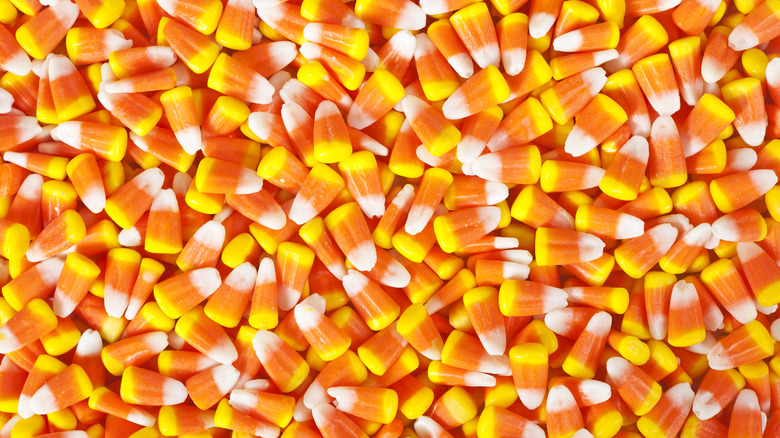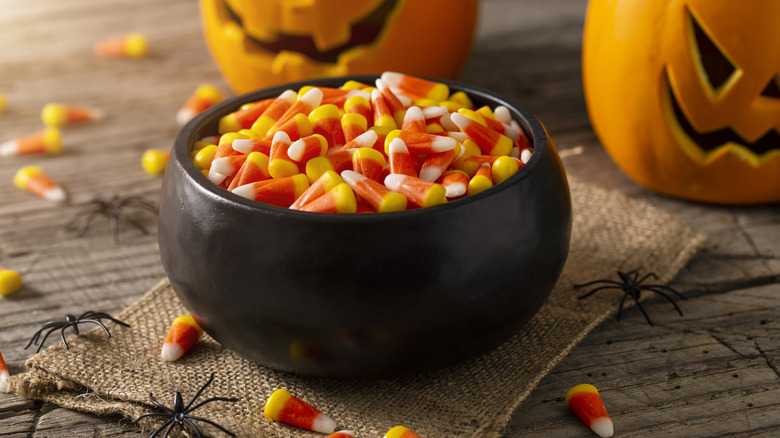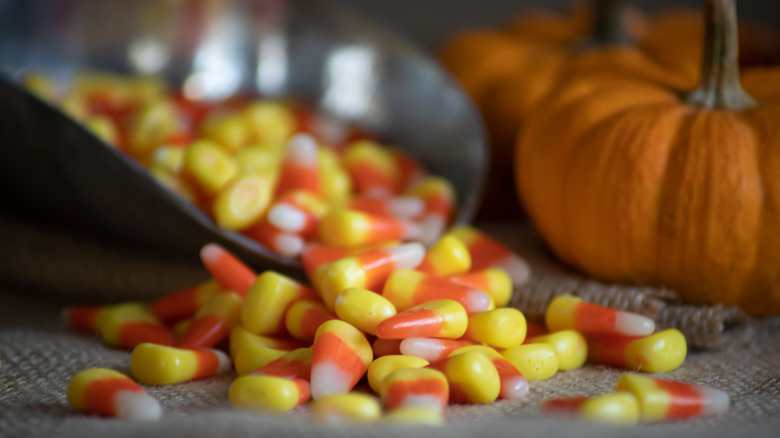Candy Corn Wasn't Always A Once-A-Year Halloween Treat
In the same way that chocolate bunnies are reserved for Easter or conversation hearts are only around during Valentine's Day, candy corn is a treat largely associated with Halloween. Though it's technically possible to find the product all year round, people typically don't buy candy corn until October rolls around. However, that wasn't always the case. When it first came out in the 1880s, candy corn was just another type of candy, and it had no ties to any particular season.
The treat was invented during a time when a large majority of Americans were farmers, and therefore farm-themed candy was trending. Turnip, chestnut, and clover-shaped candy were also produced around the same time, however, candy corn became popular because the design included three different colors, which at the time was uncommon and considered very impressive for a candy. While the novelty would eventually turn into a Halloween staple, initially Americans were just as eager to buy it in October as they were any other time of the year.
How candy corn became associated with Halloween
Although Halloween had been celebrated with pranks and costumes for centuries, and some communities did organize trick-or-treating as early as the 1930s, this usually involved neighbors passing around homemade baked goods, toys, or even fruit. History Channel explains that it wasn't until the late 1940s and 50s that trick-or-treating as we know it today really took off. In fact, it was the end of sugar rationing in 1947 after World War II combined with the increasing popularity of convenience food that folks began eating candy for Halloween and trick-or-treating became a Halloween tradition in which American children go door to door to gather candy from their neighbors. As for candy corn, when trick-or-treating and candy became associated with Halloween, so did the bite-sized triangular confections.
By the early 1950s when trick-or-treating was already fairly common, candy companies strategically began advertising their products in October leading up to the holiday. The Goelitz Candy Company (now The Jelly Belly Candy Company) also took advantage of the sales opportunity, highlighting its candy corn. But while other candy brands pushed their products all year long, Goelitz did most of its advertising in October. As a result, consumers started to associate candy corn with Halloween, even though the product had already been around for several decades. Despite the fact that most people only eat candy corn one month out of the year, in 2018, the National Confectioners Association told Vox that over 35 million pounds of candy corn is produced annually.
Candy corn used to be called Chicken Feed
As its name suggests, candy corn bears a resemblance to corn kernels, but why would candy makers choose corn — a seemingly random grain — to recreate in sugar? That all comes back to candy corn's original marketing. When it was first released, candy corn actually went by the name "chicken feed". Instead of the usual fall or Halloween-centric package design, the original label featured a rooster and was meant to appeal to the country's rural roots and farmers who made up half the workforce at the time.
Real chicken feed does have corn kernels in it, but eating candy shaped like chicken feed was much more about the novelty and playfulness of the idea rather than the appeal of corn. While today you might pull a kernel straight from the cob and it will be pretty tasty, at the time there weren't any sweet corn hybrids. Corn was a coarse, unpopular food that was only eaten in the form of corn flour, corn meal, or cornbread.
Chicken feed eventually became candy corn because the rooster mascot was referred to as "King of the Candy Corn Fields" on every package. The wording stuck with customers, and the name was officially changed in the 1940s, around the time trick-or-treating took off. From there candy corn's fate as a Halloween candy was sealed.


